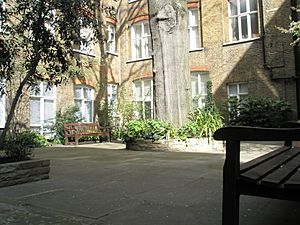St Ann Blackfriars facts for kids
Quick facts for kids St Ann Blackfriars |
|
|---|---|

St Ann's Churchyard in 2008
|
|
| Location | Ireland Yard, City of London |
| Country | England, United Kingdom |
| Denomination | Anglican |
| History | |
| Founded | 16th century |
| Architecture | |
| Demolished | 1666 |
St Ann Blackfriars was a church in the City of London, England. It was located in what is now called Ireland Yard. This church started as a small chapel in the Middle Ages. It was part of a larger monastery belonging to the Dominican Black Friars.
After King Henry VIII closed down the monasteries, a new church was built in the 16th century. This church was for the people living near the old monastery. St Ann Blackfriars was also close to the famous Blackfriars Theatre. The church was completely destroyed in the terrible Great Fire of London in 1666.
Contents
The Story of St Ann Blackfriars
The church of St Ann was built on land that used to be part of a monastery. This monastery belonged to the Dominican monks, also known as "Black Friars." King Henry VIII closed down many monasteries in England. This event is called the dissolution of the monasteries.
Building the Church
In 1550, the land where the monastery stood was given to Sir Thomas Cawarden. He was in charge of royal entertainment, like plays and shows. Sir Thomas tore down most of the old monastery buildings.
Later, during the time of Queen Mary I and King Philip, Sir Thomas had to provide a church. This church was for the people who lived in the area. The old church building had been turned into tennis courts! So, Sir Thomas let them use a small room "above a stair."
This small building fell down in 1597. The local people bought more land and rebuilt the church. They made it much bigger. They even built a storage area under the new part of the church. This new church was officially opened on December 11, 1597. It was called "The Church or Chapel of St. Ann, within the Precinct of Blackfriars." It was likely made from an old meeting hall of the friars.
In 1613, even more land was bought. An extra section, called an aisle, was added to the church. A burial vault was also built underneath. These additions were opened on July 29, 1617. In 1642, the church was repaired, costing about £500.
A Place for Puritans
St Ann's became a very important place for Puritans. Puritans were a group of Protestants who wanted to make the Church of England simpler. For 46 years, the minister was William Gouge. He was a famous Puritan leader. He died in 1653 and was buried right there in the church.
Home for Artists
Because St Ann's was on old monastery land, it had special rules. It was a "liberty" within the City of London. This meant its residents did not have to follow all the rules of the London Guilds. Guilds were like clubs for different jobs, and they controlled who could work.
Because of this, many talented artists lived in St Ann's parish. This was especially true in the late 1500s and early 1600s. These artists might have been limited by the Painter-Stainers Company, which controlled painters. Many of these artists came from other countries, especially the Netherlands. Famous artists like van Dyck, Janssens, and Isaac Oliver lived here.
The End of the Church
The church was destroyed in the terrible Great Fire of London in 1666. After the fire, St Ann Blackfriars was not rebuilt. Instead, its parish was joined with another church, St. Andrew-by-the-Wardrobe.
The land where the church stood was still used for burials. The church's old graveyard also continued to be used. This graveyard is known as Church Entry. Both graveyards stopped being used for burials in 1849. Today, they are both lovely public gardens.
Gardens for Everyone
The graveyards were turned into public gardens in 1907. This was done by the Metropolitan Public Gardens Association. A landscape designer named Madeline Agar designed them. These gardens are special because they are mostly paved. This was an unusual design for gardens at that time.

